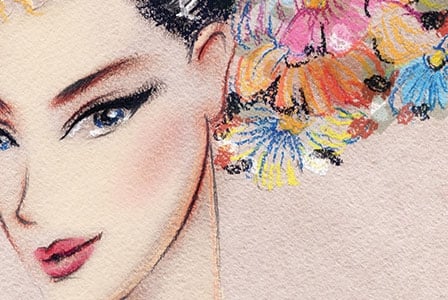
Colouring away the greys may boost our confidence, but do you know what\’s in conventional hair dye products? Before you dye, make an informed choice.
Approximately 33 percent of women over 18 and 10 percent of men over 40 colour their hair. With recent concern over the safety of beauty products, harmful chemical ingredients used in conventional hair dye have come under scrutiny. What exactly are we using to help us hide those unwanted greys?
Occupational hazard
Although today’s dyes are far less toxic than they were before 1980, some studies indicate that health risks are still present. A 2010 study revealed “an increased and statistically significant risk for bladder cancer among hairdressers, in particular for hairdressers in jobs held [for] 10 years [or].”
What can we do to ensure the hair colour we’re using is safe? Health Canada states that “it is the company’s responsibility to ensure that a cosmetic product is safe when used as intended.” As hair dye consumers, perhaps we should take the time to learn about the safety of the chemicals contained in the products we use.
Hair-raising chemicals
The following ingredients, along with their associated health risks, are typically present in conventional hair dye.
Hydrogen peroxide
As we seek to wash away the grey, we might be unwittingly contributing to hair loss! A 2012 study found hydrogen peroxide and a chemical called monoethanolamine in hair dye were associated with skin irritation and hair loss.
Ammonia
This all-purpose household cleaner displays a corrosive symbol on its packaging, and those who use it typically wear gloves. But what about when we’re colouring our hair? A 2011 study that focused on hairdressers’ exposure to ammonia linked the chemical to the development of upper respiratory tract symptoms and hand, wrist, and arm dermatitis.
Coal tar ingredients
The National Toxicology Program and the International Agency for Research on Cancer have recognized that coal tar derivatives are known human carcinogens. Some of the names that these ingredients go by are aminophenol, diaminobenzene, and p-phenylenediamine (PPD).
The European Union considers PPD to be toxic, but it’s still widely used in hair dyes in Canada. Labels of permanent and semi-permanent hair dyes must contain warnings about possible skin irritation, as well as cautions to perform a patch test before using these products. These ingredients have been known to irritate the skin, causing blistering and sensations of burning and itching.
Parabens
Ingredients such as propylparaben, butylparaben, isopropylparaben, and isobutylparaben are used as cosmetic preservatives. They may mimic estrogen and cause endocrine disruption, and developmental and reproductive disorders. Because of the overenthusiastic use of this particular chemical in cosmetics, parabens are prevalent in just about everyone’s body, according to US researchers.
Phthalates
These chemicals are known endocrine disruptors, and may cause cancer, infertility, and diabetes. They’re also present in such household items as air fresheners and sunscreen.
Resorcinol
Health Canada has deemed this chemical “not permitted in cosmetics intended for use on the skin,” because it’s irritating and toxic to the immune system. It frequently causes hair dye allergy. But doesn’t hair dye touch the scalp?
If you’ve ever suffered through an itchy, irritated scalp in the process of having your hair coloured, this information can be alarming. So, what are we willing to sacrifice for an amazing mane?
Although great hair may knock them dead, award-winning hairstylist James Abu-Ulba, education director of Spa Utopia Health and Wellness Center, insists that we don’t have to pay the ultimate price for fabulous colour.
He explains that, as a stylist with over 15 years of experience, it’s his responsibility to know the ingredients of the products he uses on his clients’ hair. He suggests that when searching for better quality and safer dyes, consumers should be willing to search out companies (and stylists) whose morals and ethics match their own.
Safety checklist
When purchasing a hair dye, look for brands that
- formulate products with low toxicity
- don’t test products on animals
- actively seek reductions in their carbon footprint
- train retailers about their products’ features
After debating the real cost of dyeing one’s hair, we can safely conclude that it’s okay to have fun with colour, as long as the dye doesn’t push us into toxic overload. We’re not sentenced to rediscover our natural shade, though it would be easier on our bodies and our pocketbooks.
By doing a little research into what we’re exposing our bodies to, we can discover a healthier alternative to our must-have hue. Make an effort to know what’s in your hair colour, and if you don’t know, then don’t dye.
Tips for safe hair colouring
Read the label to discover the ingredients in your favourite product, or ask your hair stylist. He or she should ideally know what’s in the dye they’re about to put on your hair.
- Carefully follow package directions.
- If you’re a DIY kind of person, always wear gloves.
- Always do a patch test for allergic reaction before colouring your hair.
- Colour less frequently. Many stylists usually recommend colouring every six weeks—try extending it to eight if you can.
- Don’t go extreme. Black dyes usually contain higher levels of toxic chemicals, and blonde dyes generally contain the most peroxide.
- Never dye your eyebrows or eyelashes.
- When in doubt, check Health Canada’s cosmetic ingredients “Hotlist” for a list of chemicals that have been deemed restricted or prohibited in hair dye formulas.
Safer hair dye productsLow toxicity
Ammonia levels can vary in conventional hair colour preparations. Choose dyes that don’t contain ammonia, parabens, peroxide, or phthalates whenever possible.
Natural ingredients
Choose hair dyes made of natural vegetable ingredients, such as beet and turmeric.
Henna
Made from the powdered leaves of the henna plant, henna is more time consuming to applythan commercial hair dye products. If you’re looking for grey coverage, henna must be applied properly and with due care—it can turn unsuspecting greys bright orange!




























